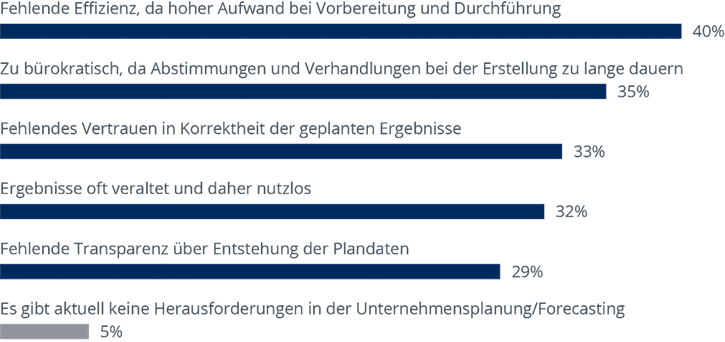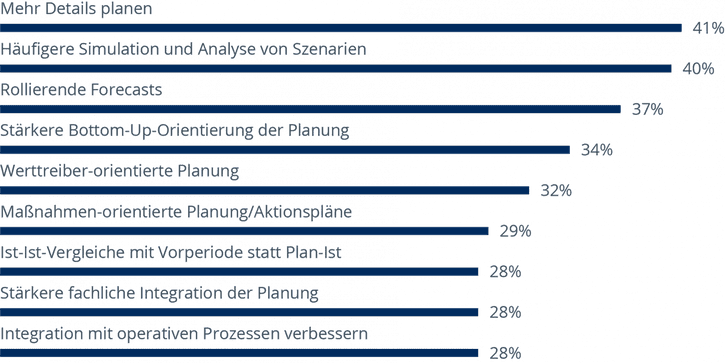What It Takes to Make Planning and Forecasting Fit for the Future
BARC (Business Application Research Center) today published the results of its topical survey “The Future of Planning – Tackling Changed Requirements with Comprehensive Modernization”.
Based on a user survey of 401 companies, the study examines the biggest challenges in forecasting and planning today as well as improvements and modernizations that can help organizations to deal with increasing complexity and dynamics. The study is available for download free of charge thanks to sponsorship by Board, Corporate Planning, Jedox, OneStream Software and Unit4.
- 89 percent of companies think that the predictability of global events with an impact on their business is low to zero
- Lack of efficiency and excessive bureaucracy are the biggest criticisms of corporate planning today
- Companies are investing in more detailed planning, simulations and rolling forecasts to tackle increasing challenges
According to a new BARC survey, 89 percent of companies think that predicting global events and future developments with sufficient reliability is not possible. Major global developments such as the pandemic are difficult to foresee and thus even more drastic for many organizations.
To be able to face future events and developments in dynamic environments, suitable strategies and measures are needed – as the survey shows. While planning and forecasting require substantial modernization in many companies, some have to address more mundane challenges first.
Challenges in planning and forecasting exist in almost every company
“Planning and forecasting are viewed with suspicion in many organizations. They take too long, tie up too many resources, produce high costs and the quality of the results does not reflect the effort involved,” said Robert Tischler, Senior Analyst Data & Analytics at BARC and co-author of the study. The survey results confirm many of these criticisms.
Only 5 percent of the companies surveyed state that they currently have no challenges in this area. The key issues relate primarily to the efficiency (40 percent), duration (35 percent) and transparency (33 percent) of planning processes and results (see Figure 1).

But what are the root causes of these challenges? The time-consuming consolidation of data from various source systems demands lots of effort, but also delays the provision of vital information. 50 percent of companies state that merging data from many source systems is very time consuming. The need to leverage data from many sources is by far the top cause for many of the challenges companies are currently facing.
“In dynamic business environments, time is money. If organizations make the right decisions based on relevant data faster than their competitors, they can exploit market potential faster than others,” said Tischler.
“Fast-changing buying patterns and short-lived trends require companies to continuously forecast and adjust the trajectory of their business. What used to be inconveniences, such as inefficient planning and forecasting and outdated results, are becoming questions of surviving or thriving amid ever fiercer competition. Fast and reliable forecasts help to determine future courses of action.
Today, companies require sound automated projections, which in turn require high quality data from a growing number of sources. Not being capable to handle data efficiently and effectively often means not being able to satisfy customers better than competitors.”
Companies are extending the reach of planning and enhancing simulations and forecasts
As most companies are facing severe challenges, they are investing in measures to modernize and enhance their planning and forecasting to tackle changing requirements (see Figure 2).

The number one measure, pursued by 41 percent of survey respondents, is to extend the scope of planning and forecasting beyond finance by integrating operational sub-plans. Furthermore, investing in more frequent simulations and scenarios was another important measure taken by 40 percent.
“Simulations are essential for understanding alternative courses of action. Done correctly, they provide invaluable information for decision-makers,” said Dr. Christian Fuchs, Senior Analyst Data & Analytics at BARC and co-author of the study.
“Increasing dynamics and the associated uncertainty raise the value of simulations for corporate management. They help companies to thoroughly assess and compare potential developments. Many organizations have recognized the benefits of simulations and scenario analyses and have stepped up their use.”
Moreover, the survey results show that 37 percent of companies are investing in switching their year-end forecasts to rolling forecasts. Rolling forecasts provide greater value for management in turbulent times and consume fewer resources than lengthy annual planning.
This measure allows companies to cope with increasing dynamics by updating their planning and forecasting more frequently. However, this needs to be flanked by substantial automation and better data management to reach that goal.
About The Survey
“The Future of Planning – Tackling Changed Requirements with Comprehensive Modernization” is a topical BARC survey assessing the challenges companies currently face in planning and forecasting due to increased complexity and dynamics and how to overcome them. The study is based on a worldwide survey of 401 companies of various sizes and industry sectors. The focus of the study is to assess what improvements are needed and how it can be ensured that they meet current requirements and move companies forward. The authors of the study are Dr. Christian Fuchs and Robert Tischler, Senior Analysts for Data & Analytics at BARC.
Click here to view the infographic and download the full study.
